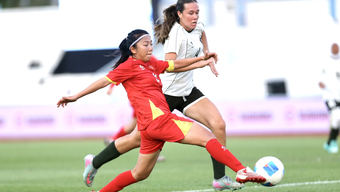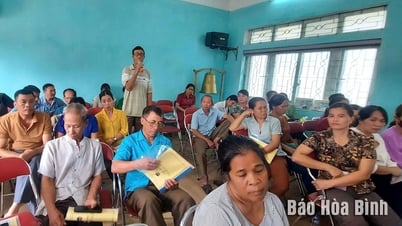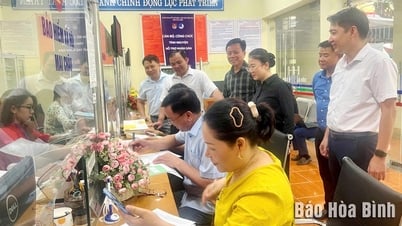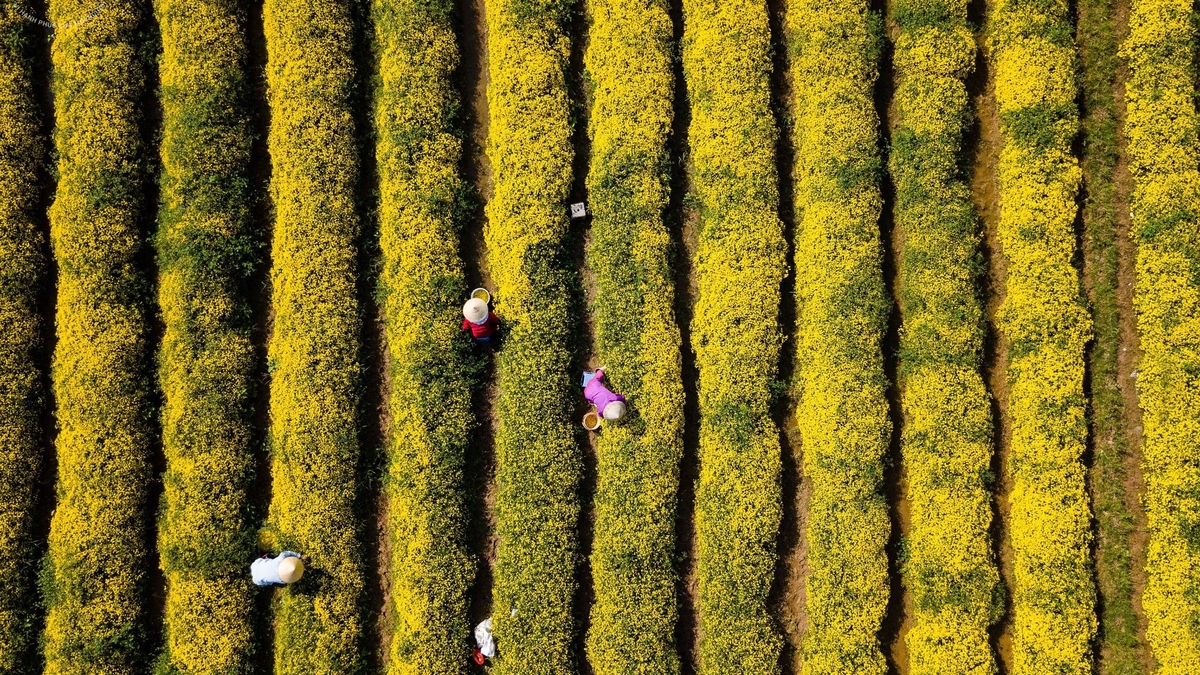
Officials from the Hoa Binh City Agricultural Service Center guide farmers in inspecting rice plants for pests and diseases. Photo: Thanh Hang (CTV)
To minimize damage caused by pests and diseases, agricultural agencies recommend the following measures for caring for and controlling pests and diseases in spring rice crops:
1. Watering and fertilizing:
Good water management is crucial for irrigating spring rice crops. Farmers can use water pumps and irrigation canal systems to bring water to the fields. It is important to use clean, safe water, avoiding dirty water or water containing harmful substances, as these can affect the growth and development of the rice plants.
When caring for spring rice crops, farmers need to pay attention to irrigation cycles to ensure sufficient water, helping the rice grow well and achieve the highest yield. In areas with complete irrigation systems, from the time the rice plants begin to tiller, irrigation should be carried out according to the "shallow - exposed - dry" formula. Alternating shallow irrigation and moisture retention helps the rice tiller early, vigorously, and densely. When the rice reaches its maximum number of tillers, drain the water to expose the roots, allowing them to grow deeper and increasing the plant's resistance to lodging.
- Fertilizing rice plants is done in two stages: Stage 1, when the rice begins to tiller, apply nitrogen and potassium fertilizers; combine this with weeding and stirring the mud to mix the fertilizer with the soil. Stage 2, when the rice begins to differentiate panicles and develop tillers, observe if 10% of the main tillers have constrictions at the leaf tips, or if the main tillers show two distinct stem nodes or the apical meristem beginning to differentiate flower buds, then apply the remaining nitrogen and potassium fertilizers. Intensify field inspections, care, weeding, and fertilization to ensure adequate, balanced, and proper technical procedures for healthy rice growth and development.
2. Pest and disease control:
- Rice planthopper infestation: Brown planthopper and white-backed planthopper (third generation) peak in damage from mid-April to mid-May. Farmers need to proactively investigate and detect planthopper outbreaks early, only spraying chemical methods when the planthopper density is high (> 1,500 individuals/m2), focusing spraying on planthopper outbreaks and infected fields, avoiding widespread spraying across the entire field to prevent late-season outbreaks. For rice fields infected with planthoppers and experiencing yellowing leaves due to nutrient deficiency, spray to control planthoppers when the density exceeds 1,000 individuals/m2, combined with treatment for yellowing leaves.
For rice in the tillering-panicle differentiation stage, use one of the following insecticides: Amira 25WG; Brimgold 200Wp, Vithoxam 350SC; Cheestar 50WG; Chersieu 50WG… or other insecticides registered for use in Vietnam to control rice planthoppers. Spray according to the recommended concentration and dosage indicated on the packaging.
For rice in the heading, flowering, and pollination stages, use one of the following contact insecticides: Nibas 50EC; Virtako® 40WG, Comda Gold 5WG, Mopride 20WP; Bassa 50EC, Mofitox 40EC, Butyl 400SC; 10WP, or other insecticides registered for use in Vietnam to control rice planthoppers. Spray according to the recommended concentration and dosage indicated on the packaging. When spraying, part the rice plants and direct the spray nozzle downwards to ensure direct contact of the insecticide with the planthoppers.
- Leaf roller: The second generation of leaf rollers damages rice crops from early to mid-April, while the third generation damages from late April to mid-May. Apply chemical control measures during the tillering stage - peak tillering stage, when the density of larvae exceeds 50 larvae/m2; and during the heading - flowering - flowering stage, when the density of larvae exceeds 20 larvae/m2.
One of the following pesticides can be used: Virtako® 40WG; Goldmectin 36EC, 60SC, 70WG, Mectinstar 20EC, Emalusa 50.5WSG, Netoxin 18SL... or other pesticides listed in Vietnam that are registered for use in controlling rice leaf roller. Spray according to the concentration and dosage instructions on the packaging.
- Rice blast disease: Leaf blast continues to cause damage on susceptible varieties and in areas with previous outbreaks. The disease tends to cause severe damage in cloudy, foggy conditions at night and early morning, with temperatures ranging from 20-28°C. Neck blast develops and causes damage on susceptible varieties and in areas with previous outbreaks from the end of April on early crops and in mid-May on the two main and late crops; it causes severe damage in areas where the disease source is already present on the leaves and in areas where proactive measures have not been taken to control leaf blast disease.
For rice fields affected by disease: Maintain sufficient water levels, stop applying nitrogen fertilizers, growth stimulants, or foliar fertilizers containing nitrogen; use specific pesticides to treat newly emerging disease outbreaks to prevent them from spreading into an epidemic. For fields already infected with leaf blast, spray to prevent neck blast when the rice begins to flower, and repeat the spraying 5-7 days after the first.
One of the following pesticides can be used to control rice blast disease: Filia® 525SE; Amistar® 325SC; Fuji-One 40EC, 40WP; Beammy-kasu 300SC, 800WG; Trizole 400SC, 75WP, 75WG; Bulny 850WP; Abenix 10SC... or other pesticides listed in the Catalogue of Plant Protection Products Permitted for Use in Vietnam. For severely affected fields, a second application should be done 2-3 days after the first.
- Bacterial leaf blight and bacterial stripe disease develop severely from mid-April to the end of the season, especially after thunderstorms. For areas planted with susceptible varieties or areas with previous disease outbreaks, one of the following pesticides can be used for prevention: Fujimin 20SL, 50WP, Golcol 20SL, 50WP, Kamycinusa 75SL, 76WP... or other pesticides registered for use in Vietnam to control these diseases.
For diseased fields, maintain sufficient water, temporarily stop applying nitrogen fertilizer or foliar fertilizers containing nitrogen or growth stimulants, and use one of the following pesticides: Starner 20WP; Norshield 86.2WG; Apolits 30WP; 80 WP; Aliette 800 WG; Starsuper 10SC, 20WP, 21SL; Supervery 50WP; Saipan 2SL... to control the pest, or other pesticides registered for use in Vietnam to control this pest.
- Rice blast disease causes damage from mid-April on rice crops, with peak damage occurring around April 30th. Infected fields need to maintain sufficient water, avoid applying nitrogen fertilizer or foliar fertilizers containing nitrogen, and can use one of the following pesticides: Tilt Super® 300EC, Vanicide 5SL, 5WP; Anvil® 5SC, Dibazole 5SC; Nevo® 330EC, Grandgold 80SC, 510WP; Kansui 21.2WP... or other pesticides registered for use in Vietnam except for this disease.
- To control rat infestations, clean up bushes and weeds around embankments and ditches to limit hiding places and breeding grounds for rats. When rats cause damage, mobilize farmers to catch them en masse. One of the following pesticides can be used: Rat-Kill 2%DP, Killmou 2.5DP, Ran part 2%DS, 0.6AB, Klerat® 0.005% wax block bait, 0.005 pellete, Storm 0.005% block bait... or other pesticides listed in the Vietnamese approved list for controlling this pest.
* Some notes on pest and disease control:
Conduct regular inspections to detect and promptly eliminate pests and diseases on crops. In case of widespread pest and disease outbreaks, use pesticides, prioritizing biological pesticides to protect the environment and human health.
Farmers should pay attention to applying the "four correct principles," including: the right pesticide, the right time, the right concentration and dosage, and the right method. It's best to spray in the morning when the dew has dried or in the cool afternoon. Do not spray when the air temperature is above 33°C, or when it is about to rain or has just rained and the rice leaves are still wet. Fields that have just been sprayed and then rained need to be re-sprayed. Use insect traps to attract and catch pests and insects that harm rice plants.
Provincial Agricultural Extension Center
Source: https://baohoabinh.com.vn/12/200414/Cham-care,-protect-spring-rice-to-develop-well,-achieve-high-yield.htm


![[Photo] Prime Minister Pham Minh Chinh receives the Governor of Tochigi Province (Japan)](/_next/image?url=https%3A%2F%2Fvphoto.vietnam.vn%2Fthumb%2F1200x675%2Fvietnam%2Fresource%2FIMAGE%2F2025%2F12%2F16%2F1765892133176_dsc-8082-6425-jpg.webp&w=3840&q=75)
![[Image] The tenacious fighting spirit of Vietnamese women's football](/_next/image?url=https%3A%2F%2Fvphoto.vietnam.vn%2Fthumb%2F1200x675%2Fvietnam%2Fresource%2FIMAGE%2F2025%2F12%2F17%2F1765990260956_ndo_br_4224760955870434771-copy-jpg.webp&w=3840&q=75)


![[Live] 2025 Community Action Awards Gala](/_next/image?url=https%3A%2F%2Fvphoto.vietnam.vn%2Fthumb%2F1200x675%2Fvietnam%2Fresource%2FIMAGE%2F2025%2F12%2F16%2F1765899631650_ndo_tr_z7334013144784-9f9fe10a6d63584c85aff40f2957c250-jpg.webp&w=3840&q=75)
























































































Comment (0)